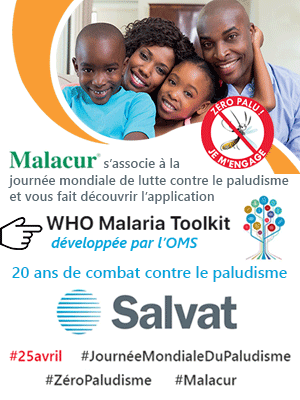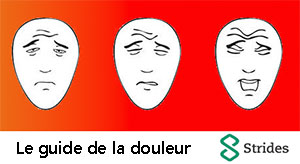← retour Santé tropicale
Accès aux sites pays ![]()
![]() BENIN
BENIN![]() BURKINA FASO
BURKINA FASO![]() CAMEROUN
CAMEROUN![]() CENTRAFRIQUE
CENTRAFRIQUE![]() CONGO
CONGO![]() COTE D'IVOIRE
COTE D'IVOIRE![]() GABON
GABON
![]() GUINEE
GUINEE![]() MADAGASCAR
MADAGASCAR![]() MALI
MALI![]() R.D. CONGO
R.D. CONGO![]() SENEGAL
SENEGAL![]() TOGO
TOGO
← retour Santé tropicale
Accès aux sites pays ![]()
![]() BENIN
BENIN![]() BURKINA FASO
BURKINA FASO![]() CAMEROUN
CAMEROUN![]() CENTRAFRIQUE
CENTRAFRIQUE![]() CONGO
CONGO![]() COTE D'IVOIRE
COTE D'IVOIRE![]() GABON
GABON
![]() GUINEE
GUINEE![]() MADAGASCAR
MADAGASCAR![]() MALI
MALI![]() R.D. CONGO
R.D. CONGO![]() SENEGAL
SENEGAL![]() TOGO
TOGO

Publié dans Médecine d'Afrique Noire 6312 - Décembre 2016 - pages 613-621
 Profil hématologique des travailleurs d’une entreprise de raffinage à Abidjan
Profil hématologique des travailleurs d’une entreprise de raffinage à AbidjanAuteurs : Y.M Kouassi, I.N.A Aka, L. Nigue, A.F Tchicaya, A.L.T Curney, Y.A Kouadio, C.P Guiegui, K.G Koffi, J.S Bonny - Côte d'Ivoire
Introduction : Pour les travailleurs exposés aux hydrocarbures, l’hémogramme est important dans la surveillance médicale spéciale.
Objectif : Etudier les anomalies hématologiques chez les travailleurs exposés aux hydrocarbures dans le domaine de la raffinerie.
Méthode : Nous avons conduit une enquête rétrospective analytique des données de l’hémogramme des travailleurs d’une entreprise de raffinage à Abidjan. Ont été pris en compte, les dossiers médicaux des travailleurs comportant un hémogramme à l’embauche et à la 10ème année d’activité. Les tests statistiques de Khi2 et de Fisher ont été utilisés pour l’étude de relations entre les anomalies et les facteurs d’exposition professionnelle.
Résultats : L’étude a concerné 118 (19,31%) dossiers médicaux. Les travailleurs étaient âgés de 34 ans à 59 ans avec une moyenne de 44 ± 6 ans. Les hommes étaient au nombre de 105 agents (88,98%) contre 13 femmes (11,02%). De l’embauche à la 10ème année d’activité, les valeurs des hématies étaient normales pour 93,3% et 86,4% des travailleurs. Le taux d’hémoglobine était diminué à l’embauche pour 3 agents (2,5%) et pour 7 personnes (6%) à la 10ème année d’activité. Ce sont 10 agents (8,5%) qui avaient une leucopénie à l’embauche et 15 agents (12,8%) à la 10ème année d’activité. Une thrombopénie a été observée chez 5 (4,2%) travailleurs à l’embauche et chez 7 (6%) travailleurs après 10 années d’activités.
Discussion : Les perturbations de l’hémogramme ont été également rapportées par différentes études sur l’exposition aux hydrocarbures mais avec des proportions différentes.
Conclusion : L’interprétation de l’hémogramme est délicate en dehors des grandes anomalies évocatrices.
Introduction: For workers exposed to hydrocarbons, the cell count is important in the special medical surveillance.
Objective: To study the hematological abnormalities in workers exposed to hydrocarbons in the area of the refinery.
Methods: We conducted a retrospective and analytical survey of the blood count data of refining company’s workers in Abidjan. We considered, medical records of workers with blood count when hiring and in the 10th year of operation. Khi2 and Fisher statistical tests were used to study the relationships between the abnormalities and exposure to occupational factors.
Results: The study included 118 (19.31%) workers aged 34 to 59 years with a mean of 44 ± 6 years. The men were among 105 workers (88.98%) and the women were 13 (11.02%). At the hiring period and the 10th year of activity, erythrocytes values were normal for 93.3% and 86.4% of workers. The hemoglobin level was reduced to hiring agents for 3 (2.5%) and was reduced to 7 people (6%) in the 10th year of operation. There were 10 officers (8.5%) who had leukopenia hiring agents and 15 (12.8%) in the 10th year of operation. Platelets were reduced to hiring workers in 5 (4.2%) and in 7 workers (6%) after 10 years of activity. The following laboratory parameters were increased with job tenure: microcytosis (P = 0.00) and monocytosis (P = 0.04).
Discussion: blood count's disturbances were also reported by various studies but with different proportions in workers exposed to hydrocarbons.
Conclusion: The interpretation of blood count is difficult outside the major abnormalities.
Cet article est actuellement coté ![]() (1,0 étoiles) par les abonnés de Médecine d'Afrique Noire.
(1,0 étoiles) par les abonnés de Médecine d'Afrique Noire.
Il a été consulté 2705 fois, téléchargé 39 fois et évalué 1 fois.
Aucun commentaire n'a encore été ajouté à propos de cet article
Restez informés : recevez, chaque mercredi, la lettre d'informations de Santé tropicale. Inscriptions
Ce contenu gratuit vous est destiné :








![]() Adresse
Adresse
![]() Téléphone
Téléphone
![]() Contactez-nous
Contactez-nous
Actualités
Articles médicaux